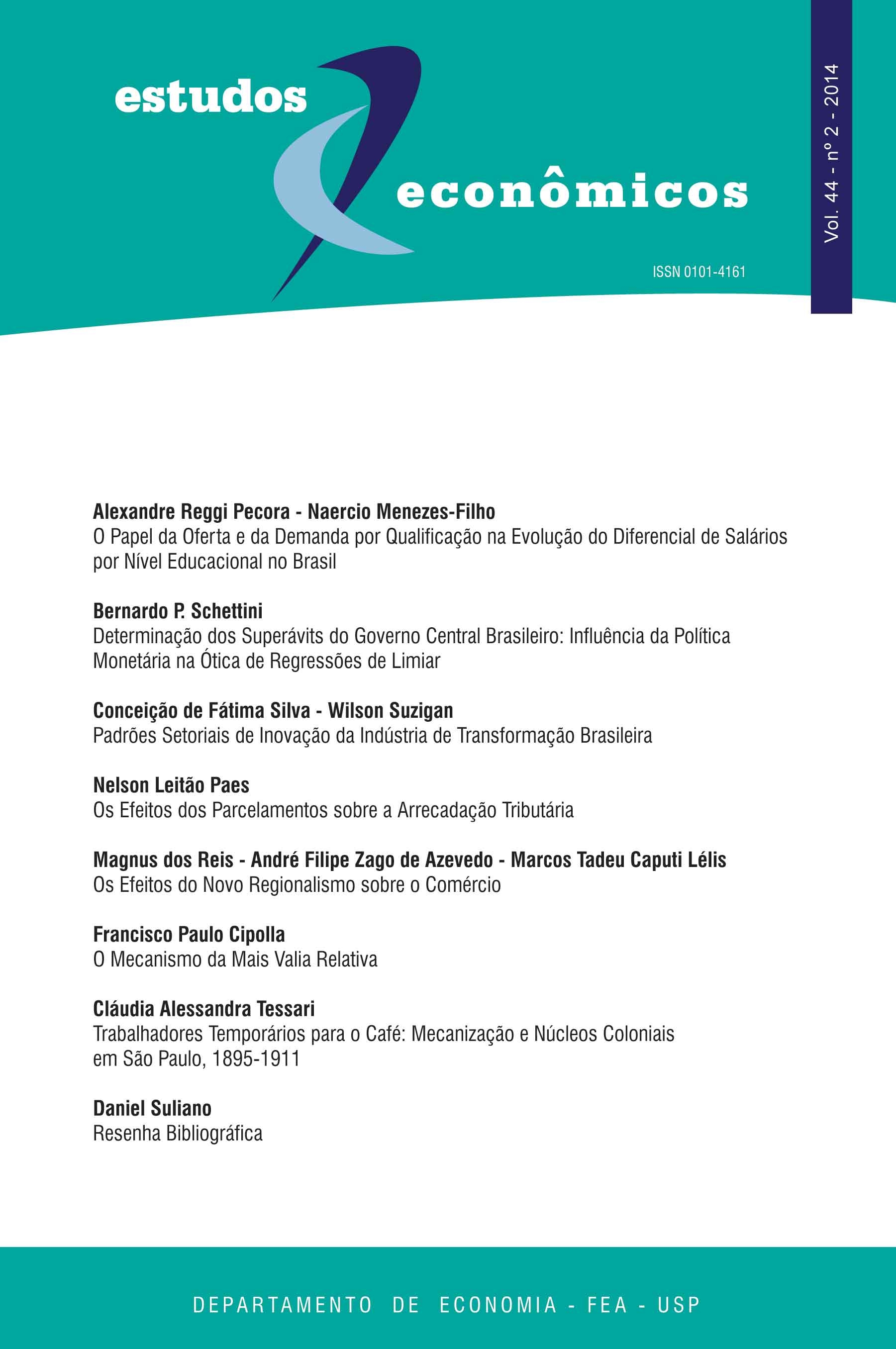O papel da oferta e da demanda por qualificação na evolução do diferencial de salários por nível educacional no Brasil
DOI:
https://doi.org/10.1590/1980-53574421apnfKeywords:
Skill premium, Supply, DemandAbstract
The aim of this paper is to assess the impact of supply and demand for skills in the wage
differentials between skilled and unskilled workers in Brazil, during 1992 and 2009. To do
so, a microeconomic model of supply and demand for skill was used where a worker’s
skill is directly linked with its educational level. A rise in the skill premium (wage differentials
between college and less than college workers) was observed between 1992
and 2001, driven by the demand for skilled labor. Between 2002 and 2009, a slight
decrease in the skill premium was observed, which was driven by the intensification
of the relative supply of skilled workers.
Downloads
References
ACEMOGLU, D. e AUTOR, D. (2011), “Skills, Tasks, and Technologies: Implications for Employment and Earnings” in O. Ashenfelter and D. Card, eds., Handbook of Economics, Amsterdam: North-Holland, Vol. IV.B: 1043-1172.
ATKINSON, A.; PIKETTY T.; SAEZ E. (2011). “Top Incomes in the Long Run of History,” Journal of
Economic Literature, American Economic Association, vol. 49(1), pages 3-71, March.
AUTOR, D.; LAWRENCE F.; KRUEGER, A. (1998). “Computing Inequality: Have Computers
Changed The Labor Market?,” The Quarterly Journal of Economics, MIT Press, vol. 113(4),
pages 1169-1213.
AUTOR, D.; KATZ, L.; KEARNEY, M. (2006). “The Polarization of the U.S. Labor Market,” NBER
Working Papers 11986, National Bureau of Economic Research, Inc.
BARROS, R. P.; FOGUEL, M.; ULYSSEA, G. (2006), “Sobre a Recente Queda da Desigualdade de
Renda no Brasil”. In: BARROS, R. P.; FOGUEL, M.; ULYSSEA, G. (org) Desigualdade de renda
no Brasil: uma análise da queda recente. – Brasília: IPEA, Nota técnica. v.1.
BONELLI, R. e RAMOS, L. (1995) “Distribuição de Renda no Brasil: Avaliação das Tendências de
Longo Prazo e Mudanças na Desigualdade desde Meados dos Anos 70”, Revista Brasileira de
Economia, vol. 49, pp. 353-73.
BRESSAN, G. S.; HERMETO. “Polarização do mercado de trabalho sob viés tecnológico e impactos sobre diferenciais salariais por gênero”. In: XXXVII Encontro Nacional de Economia, 2009, Foz do Iguaçu. TRABALHOS APROVADOS, 2009.
CACCIAMALI, M. (1991) “As Economias Informal e Submersa: Conceitos e Distribuição de renda”, in Camargo e Giambiagi (eds) Distribuição de Renda no Brasil. Paz e Terra.
CAMARGO, J. e NÉRI, M. (1999) “Distributive Effects of the Brazilian Structural Reforms”, Anais
do XXVII Encontro Nacional de Economia, pp. 1845-1868.
CARD, D. e LEMIEUX, T. (2001). “Can Falling Supply Explain the Rising Return to College for
Younger Men?” Quarterly Journal of Economics 116, 705–746.
CARNEIRO, P. e LEE, S. (2009). “Estimating distributions of potential outcomes using instrumental variables with an application to changes in college enrolment and wage inequality”, Abril 2009, Journal of Econometrics, Vol. 149, No. 2, pp. 191-208, Elsevier, Journal Articles.
FIRPO, S., FORTIN N., e LEMIEUX T. (2011). “Occupational Tasks and Changes in the Wage Structure.” Working paper,
FIRPO, S. & REIS, M. C. (2007), O salário mínimo e a queda recente da desigualdade no Brasil, in ‘Desigualdade de renda no Brasil: uma análise da queda recente. Vol. 2. Brasília’, IPEA.
FERNANDES, R; MENEZES-FILHO, N. (2012) “Educação, Salários e a Alocação de Trabalhadores
entre Tarefas: Teoria e evidências para o Brasil”. Pesquisa e Planejamento Econômico, 42, n.3,
-56.
GIOVANETTI, B.; MENEZES-FILHO, N. (2006). Trade Liberalization and Demand for Skill in Brazil
Economía (LACEA): 7, no.1, 1-28.
GONZAGA, G.; MENEZES-FILHO, N. A.; TERRA, C. (2005) “Trade liberalization and earnings differentials in Brazil”. Journal of International Economics, v. 68, n. 2, p. 345-367.
HENRIQUES, R., (2001). Desigualdade Racial no Brasil: Evolução das Condições de Vida na Década de 90. Texto para Discussão 807. Rio de Janeiro: Instituto de Pesquisa Econômica Aplicada.
HOFFMANN, R. (1995) “A Desigualdade e Pobreza no Brasil no Período 1979-90”, Revista Brasileira de Economia, vol.49, pp.277-94.
KATZ, L.; MURPHY, K. (1992). Changes in relative wages: supply and demand factors. Quarterly
Journal of Economics, v. 107, p. 35-78
LAM, D. e SCHOENI, R. (1973) “Effects of Family Background on Earning and Returns to Schooling: Evidence from Brasil”, Journal of Political Economy, vol. 101, pp.711-738.
LINDLEY, J. e MACHIN, S. (2011). “Rising Wage Inequality and Postgraduate Education”, DP1075, Centre for Economic Performance, London School of Economics.
MANACORDA, SÁNCHEZ-PÁRAMO e SCHADY, (2010). “Changes in Returns to Education in Latin
America: The Role of Demand and Supply of Skills,” Industrial and Labor Relations Review, ILR
Review, ILR School, Cornell University, vol. 63, No. 2 (jan.), pp. 307-326.
MENEZES-FILHO, N. e RODRIGUES, M. (2003). “Tecnologia e Demanda por Qualificação na Indústria Brasileira”. Revista Brasileira de Economia, Vol. 57, No 3.
MENEZES-FILHO, N. e TAVARES, P. (2011). “Human Capital and the Recent Fall of Earnings Inequality in Brasil”. Universidade de São Paulo, mimeo.
Downloads
Published
Issue
Section
License
Copyright (c) 2014 Alexandre Reggi Pecora, Naercio Aquino Menezes-Filho

This work is licensed under a Creative Commons Attribution-NonCommercial 4.0 International License.
By submitting an article, the author authorizes its publication and attests that it has not been submitted to any other journal. The original article is considered final. Articles selected for publication are proofread for grammatical and orthographic errors. The journal does not pay rights for published articles. The Institute of Economic Research from the School of Economics, Business and Accounting of the University of São Paulo (Instituto de Pesquisas Econômicas da Faculdade de Economia, Administração e Contabilidade da Universidade de São Paulo) owns the journal's copyright.




